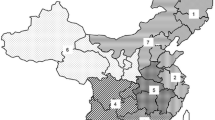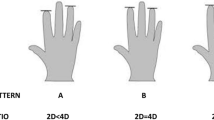Abstract
The purpose of this paper is to provide a descriptive analysis of dermatoglyphic traits of the palm in a North-Italian population. For this purpose we collected and studied the dermatoglyphic prints of 420 subjects (211 males and 209 females) from Bologna. Sexual and bimanual differences were pointed out for several palmar traits, especially with reference to the occurrence of palmar patterns. The trend of palmar traits of our sample was compared to the one of other Italian samples available from literature. The occurrence of modal types of main lines of Italian samples is always within the range of the general variability of Caucasians. The results of our study, in addition to the well-known biological importance of dermatoglyphics as indicative traits of a population, suggest a need for further analysis of palmar dermatoglyphics in Italy by compatible methodologies.
Similar content being viewed by others
References
Alciati G., 1963.I dermatoglifi palmari degli abitanti di Pofi (Frosinone). Rivista di Antropologia, L: 241–247.
Alciati G., Andreatta G., D'Agostini G. &Parnigotto P. P. 1978.I dermatoglifi nei Colli Euganei: confronto con altre zone d'Italia. Antropologia Contemporanea, 1: 161–173.
Barsocas C. S., Panayotou, TH., Varonos S., Kritsikis S., Plato C. C. &Papadatos C. J. 1982.Digital and palmar dermatoglyphics Research (C. S. Bartsocas, ed.),Alan R. Liss, inc.New York.
Cummins H., 1936.Cit. by Schaumann and Alter, 1976.
Cummins H. &Midlo C., 1976.Palmar and plantar epidermal ridge configurations (dermatoglyphics) in European-Americans. Am. J. Phys. Anthrop., 9: 471–502.
D'Amore C. &Galgano M., 1963.I dermatoglifi palmari in 100 maschi e 100 femmine napoletani. Rend. Acc. Sc. Fis. Mat., Napoli, 4: 315–342.
Floris G., 1975.Angolo atd e triradio assiale in un campione di Sardi. Boll. Società Sarda Scienze Naturali, 15: 1–10.
Floris G. &Maxia C., 1977.Variazioni inter-e intragruppali del conteggio a-b nei Sardi. Rend. Seminario Facoltà Scienze Università Cagliari, XLVII: 387–392.
Formicola V. &Lucchesi L., 1982.Nuovi dati sui dermatoglifi digitali e palmari in campioni apuani. Antropologia Contemporanea, 5: 255–267.
Fortich Baca V. I. 1982.Further studies on dermatoglyphic associations. pp. 157–173. In: Progress in Dermatoglyphic Research. (C. S. Bartsocas, ed.) Alan R. Liss, Inc., New York.
Gladkova T. D. &Toth T. A., 1978.Hungarian dermatoglyphics and their relation to the origin of the Hungarian People. PP. 167–176. In: Dermatoglyphics: an international perspective. (J. Mavalwala, ed.) Mouton Pub., The Hague, Paris.
Gualdi-Russo E., Zannotti M. &Cenni S. 1982.Digital dermatoglyphics in Italians. Hum. Biol., 54: 373–386.
Loesch D., 1979.Dermatoglyphic distances. Selected topics. pp. 225–248. In: Dermatoglyphics — Fifty years later (W. Wertelecki, C. P. P. Plato, eds.) Alan. R. Liss, inc., New York.
Malhotra K. C., Karmakar B. &Vijayakumar M., 1982.Progress in Genetics of palmar pattern ridge counts in man. pp. 111–128. In: Progress in Dermatoglyphic Research. (C. S. Bartsocas, ed.), Alan R. Liss, Inc., New York.
Malvalwala J. 1978.A methodology for dermatoglyphics. Fingers and Palms. pp. 19–54. In: Dermatoglyphics. An international perspective. (J. Mavalwala, ed.), Mouton Pub., The Hague, Paris.
Maxia C., Fenu A. &Floris G. 1966.Primi risultati finora acquisiti di una indagine sui dermatoglifi chirodattili e palmari di popolazioni della Sardegna centro-meridionale. Atti Ass. Genet. It., Pavia, 11: 353–377.
Maxia C., Fenu A. &Floris G. 1972.Ricerche sui dermatoglifi chirodattili, palmari e plantari in Sardegna. Arch. Antrop. Etnol., CII: 97–151.
Meier R. J., 1980.Anthropological dermatoglyphics: a review. Yearbook Phys. Anthrop., 23: 147–178.
Naffah J., 1977.Dermatoglyphic analysis: anthropological and medical aspects. Bull. New York Academy of Medicine, 53: 681–692.
Penrose L. S., 1968.Cit. by Schaumann and Alter, 1976.
Penrose L. S. &Loesch D., 1969.Dermatoglyphic sole patterns: a new attempt at classification. Hum. Biol., 41: 427–448.
Penrose L. S. & Loesch D., 1970.Cit. by Schaumann and Alter, 1976.
Plato C. C., 1970.Polymorphism of the C line of palmar dermatoglyphics with a new classification of the C line terminations. J. Phys. Anthrop., 33: 413–420.
Schaumann B. &Alter M., 1976.Dermatoglyphics in medical disorders. Springer-Verlag, New York, Heidelberg, Berlin.
Schwidetzky I. & Jantz R. L., 1977.Cit. by Meier, 1989.
Wilder H. H., 1922.Racial differences in palm and sole configurations. Palm and sole prints of Japanese and Chinese. Am. J. Phys. Anthrop., 5: 143–206.
Author information
Authors and Affiliations
Rights and permissions
About this article
Cite this article
Gualdi-Russo, E. Palmar dermatoglyphics in a sample of Italian population. Int. J. Anthropol. 2, 105–115 (1987). https://doi.org/10.1007/BF02442355
Received:
Accepted:
Issue Date:
DOI: https://doi.org/10.1007/BF02442355




